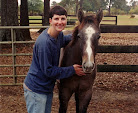One thing about cramming for my Parelli course is that it’s easy to get distracted from actually keeping my horse fit. I mean, I’ve been riding him every day, which is a deal more than he usually gets, but we’ve been spending the majority of each day in the ring and at the trot. Polocrosse practices got us briefly doing more cantering in the field, but those are on hold right now and Lupin has been starting to lose some of the fitness he’d developed there.
So I decided to make a concerted effort to get out and about at higher speeds. Today we did a fairly hilly and long trail after having done a shorter version of it two days ago. Although we had some initial disagreement about Lupin’s level of motivation for hitting the trails, we used the savvy Dan taught me for this—let him turn around if he wants, then ask him to keep turning until he’s faced back the direction I want to go. Repeat as necessary. This strategy is excellent because it doesn’t set me up to get in a fight with him, as I had been doing before. Instead, I go with his idea and ask him to keep going with that idea. So although he continues to test me periodically, it is now a non-issue to deal with it, and he eventually goes, “Oh alright then. Let’s go.”
And usually we have a few rounds of that somewhere, and then he’s okay with going adventuring. Today was no exception, and we got most of the way around the loop before we had any other challenges to deal with. Then we encountered the inevitable: a fallen pine tree blocking the trail. We’re quite used to blazing our own detours, but this one was tricky: banks almost straight up and down on either side of us. I didn’t want to go all the way back around, though, because doing so would functionally double the length of our ride.
I tried moving the tree to no avail. I looked at the down-side bank: no way. I looked at the up-side one: okay, a little tricky going up, but it looked better coming down on the far side of the tree. So I decided to go for it. But I decided to go for it off of my horse.
The bank was probably about 8 feet tall and slippery with sand, and I couldn’t have gotten up it myself without the fallen tree to hold on to. Lupin tried to come up behind me, but he couldn’t go slowly up the bank without sliding back down and I was in his way the first time he tried. But I had just enough rope to be able to get to the top myself and then ask him.
He barreled up with enough momentum to get purchase above the bank the second time. At that point, we were committed to my decision. At that point, though, Lupin had also gone a little right brain, and he started beating his own trail through the trees in the wrong direction. I had to do some hard work to get both back in front of him and above him on the slope (as I didn’t want him to slide down it onto me); then we began the process of backing him out of the spot he’d gotten himself stuck in.
Finally all turned around, we made our perilous way around the tree, only to discover that the bank I’d optimistically thought was easier wasn’t: it was still about an 8’ drop down a sandy slope that gave way under foot. At that point, I decided that Lupin and I were something of a liability to each other if we stayed attached, so I dallied his reins up and left him to decide whether to follow me as I tried to beat through a bramble to a better descent or whether to go for it.
I’m not sure whether he decided to go for it or whether the bank gave way beneath him, but he went careening down the bank, landed on the trail, and just managed to apply the brakes before he went over the other side of it and down the next bank. He bucked a little then and looked fairly perturbed, but as I held my breath from the bank above, he did not go galloping off down the trail, for which I was very grateful, as there was still a good climb and then a long walk back to the barn. He also had kept his feet the whole way, and I’ll say this for Thoroughbreds: they may be frail, but they’re also terribly athletic. Which, all things considered, may be a necessary trait for the horses I own.
As I slid behind my leading foot down the bank to join him, I had a feeling familiar to me from our previous years together of successfully overcoming a challenge with my capable partner. There was a time when I had utter confidence in Lupin’s bravery and abilities, and he seemed to have much the same in mine. It’s possible that we were just both equally deceived in each other—certainly my judgment, anyway, might be a bit suspect after the day’s detour scheme. But while Lupin would have been reasonably well within his rights, I think, to have said a big F U to me and cantered off, he remained with me instead. Maybe he was just still standing there in shock that I’d asked him to do anything so ridiculous. But I’m going to hope, for now, that he stood there and waited because my partner has returned and is ready for further adventures.



